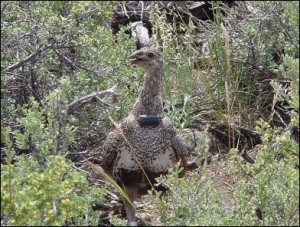
If ranchers, mineral companies and environmentalists can work together to protect the greater sage grouse, can’t Virginians work together to protect the Cow Knob salamander?
by James A. Bacon
I’ve been cogitating a lot recently over the difficulty of building major infrastructure projects in Virginia that are vital to the economy yet intrude upon landowner rights and the environment. One problem, which I dubbed the “rule of firsties,” is the spreading conviction that existing landowners (the ones who got there first) have a right to undeveloped view sheds comprised of other peoples’ property. Another problem is the near impossibility of building a highway, power line or pipeline that doesn’t impinge upon some historical home, burial plot, neolithic Indian settlement or some Freebish Loutwort of a rare species. Most recently I highlighted the ruckus over the Cow Knob salamander whose habitat lies in the proposed path of the Atlantic Coast Pipeline.
It’s more difficult building Big Infrastructure today than it was a century ago because we value things that we didn’t back then and want to protect them. We don’t like bulldozing our history and cultural heritage. We don’t like driving endangered species into extinction. We don’t like steamrolling landowners who just want to be left alone. So, what’s to be done?
There are no easy answers, just different trade-offs. But some trade-offs arguably are less painful than others. When I wrote about the Cow Knob salamander yesterday, I suggested that the Atlantic Coast Pipeline might somehow mitigate or offset the effect of its destruction to the salamander’s habitat. Frankly, I had no clear idea how that might be done, although I was thinking vaguely that we could create a mechanism like wetlands banks, in which a developer or builder offsets the destruction of wetlands by creating new wetlands somewhere else.
Could we do something similar for Cow Knob salamanders? Well perhaps we can. The Environmental Defense Fund (EDF) has taken the lead in prairie and Rocky Mountain states to create “habitat exchanges” that are doing for the greater sage grouse, the lesser prairie chicken and the mule deer what I kinda, sorta had in mind for the salamander.
Writes Fred Krupp, president of the EDF in the Wall Street Journal today:
Think of it as an Airbnb for wildlife. Just as the online company Airbnb allows homeowners to get paid for opening a spare bedroom to travelers, habitat exchanges allow landowners to get paid for providing quality habitat for vulnerable wildlife. The revenue is supplied by infrastructure, energy and other developers, which need to mitigate the environmental impact of their projects. But concerned individuals, nongovernmental organizations or corporations can also share in the cost, donating funds to an exchange. …
Though it would be ideal to set aside enough habitat to ensure the survival of the nation’s critters, practically speaking we can’t. The best alternative is to share resources so everyone wins.
I don’t know what kind of legal framework might be needed for Virginians to start creating habitat exchanges, but someone ought to take a look. We likely won’t devise a solution in time to address concerns raised by the Atlantic Coast Pipeline or the Mountain Valley Pipeline, but you can rest assured that other Big Infrastructure projects will be proposed in the future and that the same kinds of issues will be raised. We can either stagger from one zero-sum-game slug-fest to another, or we can devise options like habitat exchanges to make the inevitable trade-offs less painful. The choice is ours.
Read more about habitat exchanges here.


